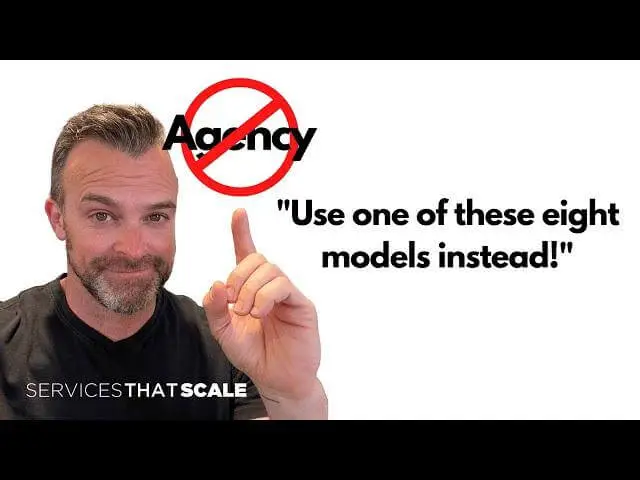In this post, I’m going to share with you the 8 best service models for digital agencies working with the small business community.
I’ll explain why I’m an anti-agency model and believe these alternatives are superior for serving small businesses profitably and at scale.
My Background: I’m Anti-Agency Model
Before we get into the actual eight services, first I’ve got to tell you an important detail here about my background and my approach to the agency business.
I am as anti-agency a business model as you are going to find. Yes, I am calling it the agency business because that’s how most people identify with this business, using the word “agency”. But the reality is the agency business model stinks!
I like to say that our goal is to get customers, not clients. When you have an agency using the traditional agency model, you are selling your time, you’re selling your talent.
Or you’re hiring people who are expensive because they have talent, and you’re selling their time.
It’s a business model that ends up getting you trapped into having needy clients who are demanding your time and want customized services provided by you or the talented people on your staff.

The Failed Promise of Serving Small Business
This business model has been tried so many times by businesses selling to the small business space because it seems like such an obvious opportunity.
You know, small businesses oftentimes just don’t have that well-rounded talent that they need in various areas of their business, including marketing. And so it just seems like a natural fi.
But the reality is small businesses can’t spend enough money with you consistently to justify selling your time and selling your talent. And make the whole business model work, which is why no big agencies are selling to the small business marketplace.
And even those that are out there that are saying they’re successful “agencies”—most of them are agencies in name only. They have a different business model, like the ones I’m going to share with you today.
Or if they are successful, it means they work their tail off and make a decent living, but they haven’t developed an asset that they can sell. And they have no free time or life.
If that’s success for you, go work in the traditional agency business model. If you’d like something different, that’s what I’m going to share with you today—models where you can have customers, not clients.
Grab My Free Training
Learn the Four Best HighLevel Services to Start a Digital Agency FAST!
Customers vs Clients
What do I mean by customers? Customers don’t have to know your name, they don’t have to have your cell phone number. They’re not going to be calling you in the middle of the night demanding things.
Those are customers. That’s what I want, that’s what you should want too!
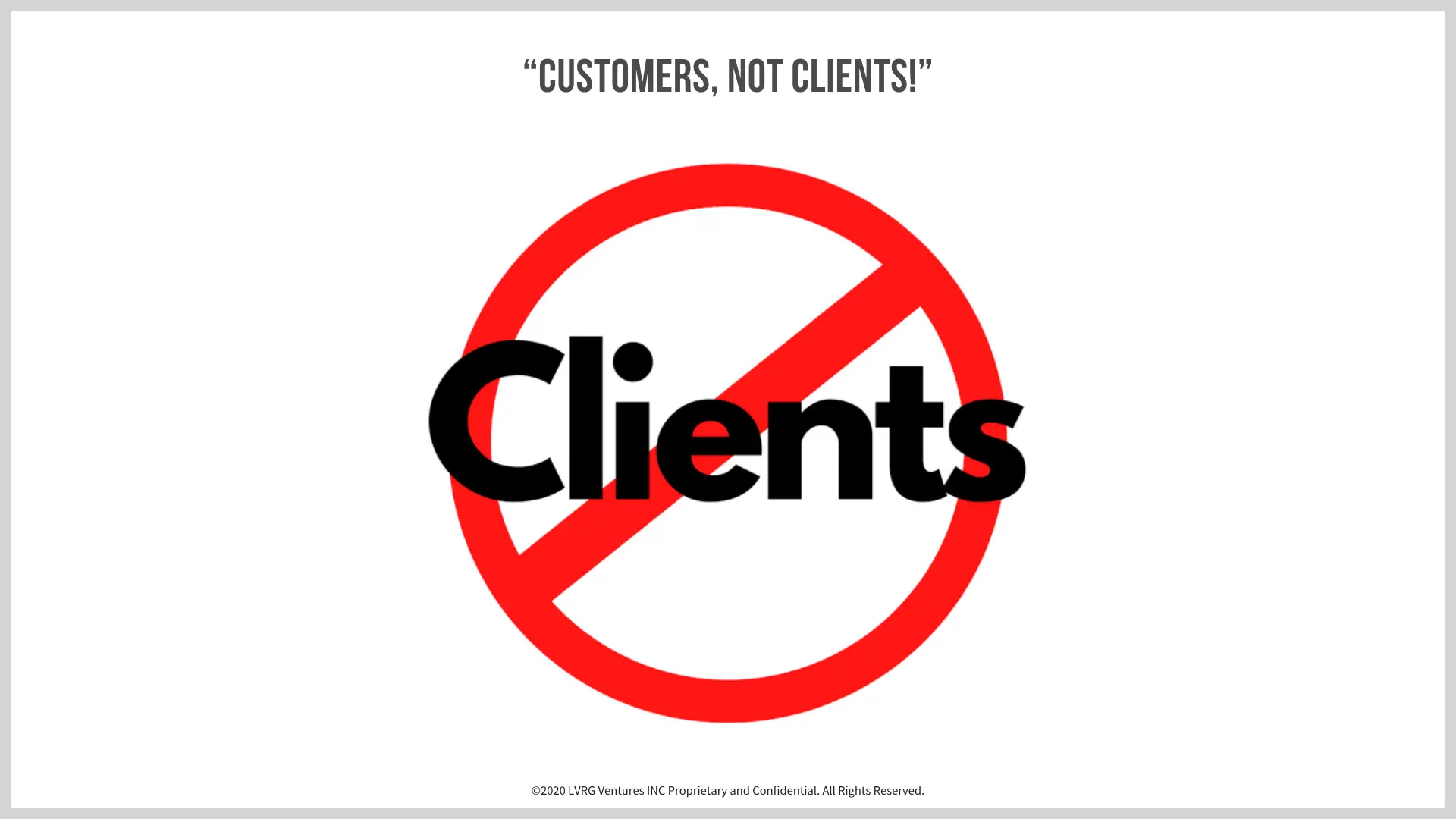
What Makes A Service Scalable
So what makes a service scalable? Let’s start with that here real quick:
Recurring Revenue
Recurring revenue is essential. You can’t have to start over every single month with a brand new sales cycle to try and generate revenue. Or you will never get ahead.
So we have to structure these services to have recurring revenue. And everything I’m going to share with you today is naturally built around that.
Established Demand
It’s got to have a pretty strong demand. That is established demand.
What I mean by that is you can’t go out selling something so innovative that you have to spend a lot of time and money educating small businesses before they’re going to understand it.
Or doing a long consultative sales process because, again, that’s just expensive, and it’s going to slow down your sales process. Not the kind of business we want.
It’s got to be something that has that established demand already.
High Margin
We’ve got to have high margins. With smaller businesses, we’re going to be selling at lower price points, so we have to have high margins to make it work.
Automagic
What do I mean by that? Well, ideally, we would sell completely automated things. So we don’t have to lift a finger and it just all magically takes care of itself.
Realistically, you won’t likely achieve complete automation, but you want to get as close as possible.

Now let’s dive into the eight best service models for digital agencies.
Model 1: Media
Service model number one here is media. I love media. ThereSanDiego—the site I’m showing you here—is my business.
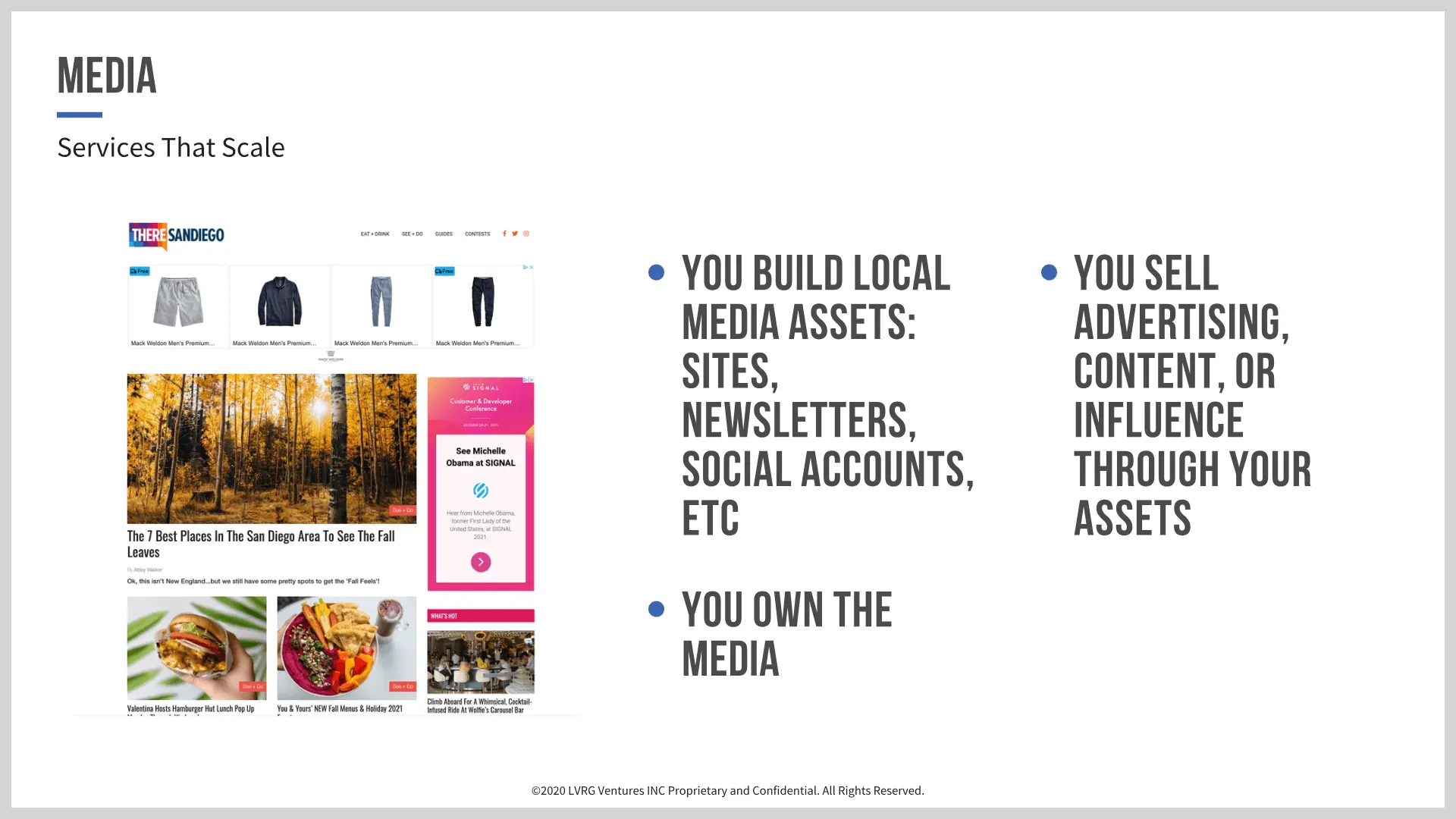
I absolutely love it.
Why do I love it? Well, I’m delivering tremendous value to small businesses in the marketplace. I’m using my media property to get businesses exposure by telling stories about them and promoting those stories on social media or through my email newsletter.
And it is a very, very simple model for my customers to understand. Every small business understands advertising.
They don’t necessarily understand SEO, PPC, and all these terms— lingo that we have in our business—but they understand the concept of advertising.
You have attention. I want some of that attention for my business, so I need to buy an ad in your content.
And the great thing is in the local space, the media has gone through a rocky period here over the last 10-15 years.
As you know, the internet essentially disrupted newspapers and radio and things like that. So there are a lot of openings now in the marketplace for people to come along, like I did with TheirSanDiego, and create a foothold relatively easily.
Awesome things about the media model:
- You own the asset. You’re creating an asset, you’re building something for you. You’re not building something for your customers, and then they own the asset. You own the asset.
- It’s simple. People understand it. This makes your sales process easy.
Model 2: Pay-Per-X
You heard me say before I don’t like agencies. And I’m sure you’ve heard and seen lead generation agencies.
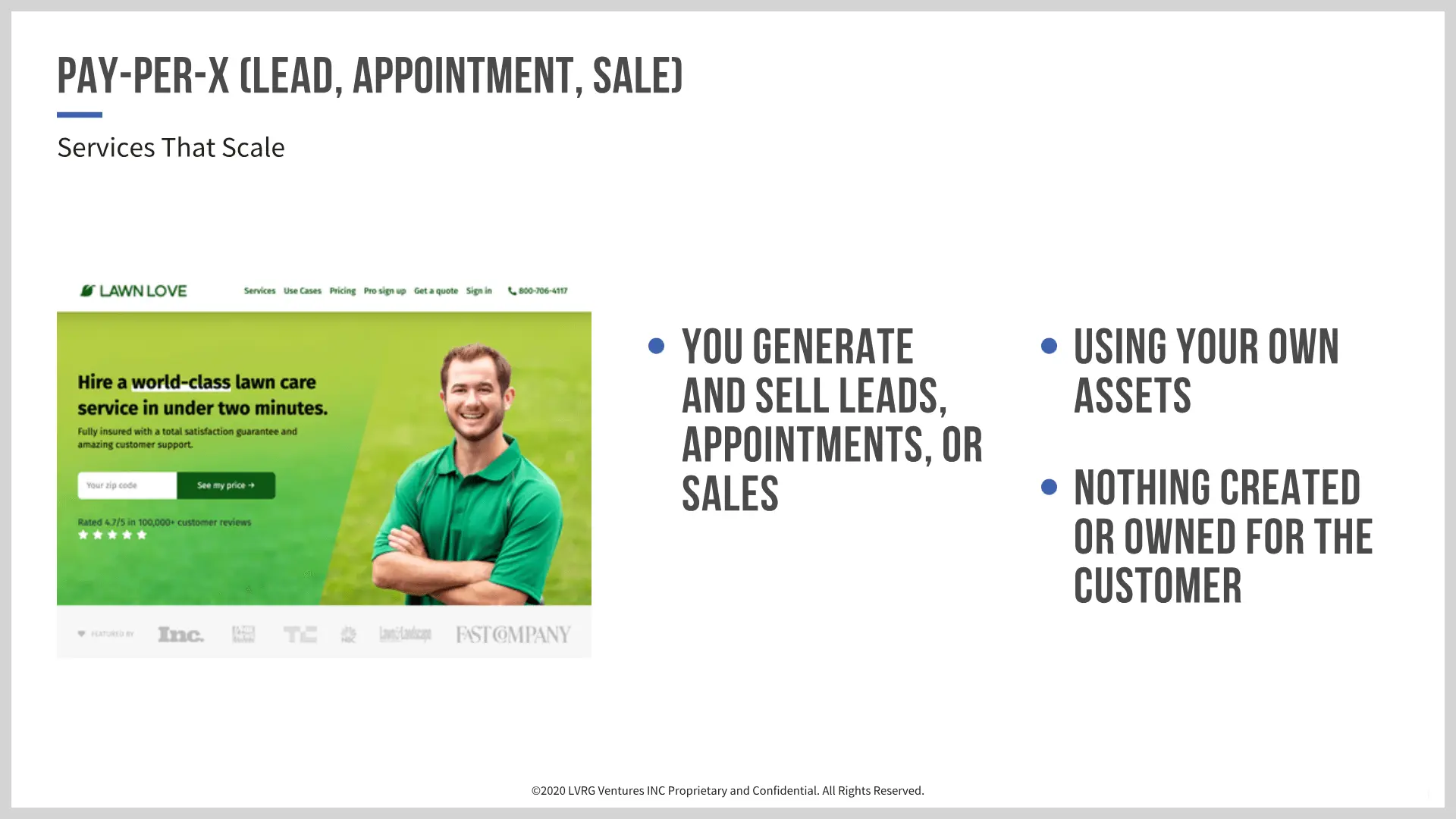
This is a very important distinction here—I’m not talking about an agency. I’m talking about a business where you build an asset that generates leads, and then you sell those leads to customers.
However, it’s not an agency.
You’re not doing campaigns on behalf of the customer. You’re not working in their ad account. You’re not creating landing pages for them. You’re creating your lead generation asset and then just selling those leads.
One of my favorite businesses in this space right now is a company called Lawn Love. It’s a brilliant lead generation business.
You could sell leads, appointments, or sales using your own assets where nothing is created or owned by the customer.
Again, you own the asset. There’s a major theme that you’ve heard here already and a central part of what makes services scalable.
A perfect example of massive success in this business is Groupon. At the time, the fastest-growing business with one billion dollars in sales in history.
And a company that just absolutely proved that if you have the right model you can sell to small businesses very, very quickly.
So lots of opportunities in this space.
Model 3: Rentals
The next model, model number three, is a model that I’ve had great success with. This was my old business Kutenda. And I’m sharing with you that’s a slide—an actual slide from my sales pitch for this service.
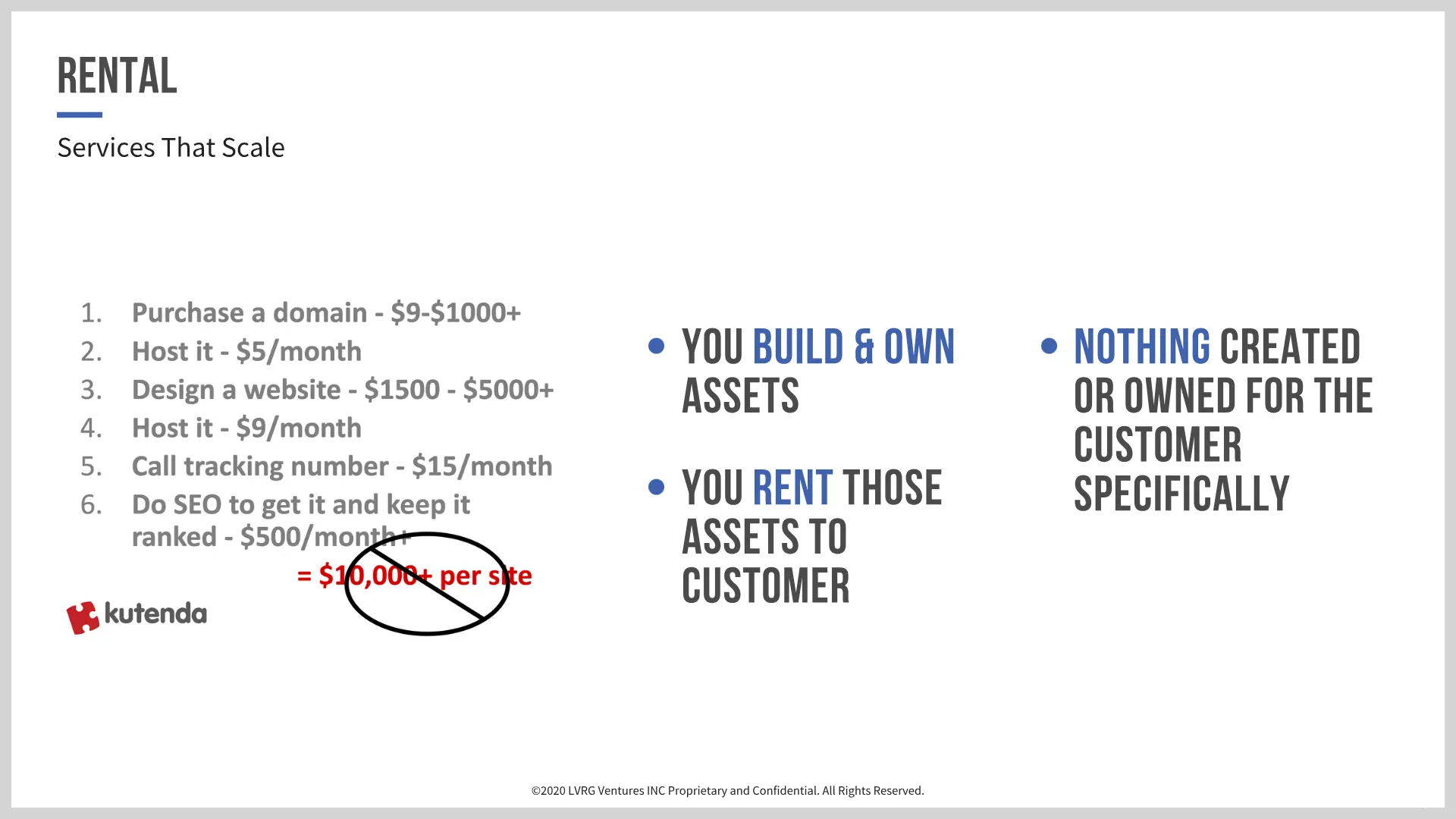
It was a “rent a site” service, and there’s a variety of things that you can do with rental now, but this one was a “rank and rent” model you’ve probably heard of before.
I built sites and ranked them, and then I would rent those sites out to customers in that particular niche for between $297 and $497 dollars a month.
So my pitch was super simple, it’s a great value proposition, right?
Hey Mr. Tax Attorney, you could build your own websites to generate more leads, but that means you’re gonna have to purchase domains, set up hosting, design the website, manage the hosting, etc.
You’re going to have to do SEO, create content, and a whole bunch of other things you probably don’t want to or can’t do.
That’s just not what your business is, right? You’re a tax attorney, you’re not a web marketer. So I build these sites and just rent them out to you instead. And I do it at a cheap monthly price that to you is a crazy deal!
Instead of spending $10,000+ to build and rank your site, and be distracted with it…you just pay me $497 a month.
It was a six-figure-a-month service for me. It’s an awesome model. It’s very simple and hands-off. Once you create the site, you can sell leads from these sites as well. So that’s going back to the asset model. You could do it either way.
The beauty of the rental model is there’s no arguing over leads…it’s just “Hey, it’s $297 a month or $497 a month, and you get whatever comes to you.” You can do this with:
- Rank and rent lead generation sites
- Websites
- Funnels—create funnels that are out there attracting prospects and customers in a particular market, and then just rent out that funnel to a business.
It’s a great, great model.
Model 4: Content as a Service
Model number four here I call “content as a service”. Again, this is me giving a pitch because I have been running a content as a service business for probably close to 10 years now.
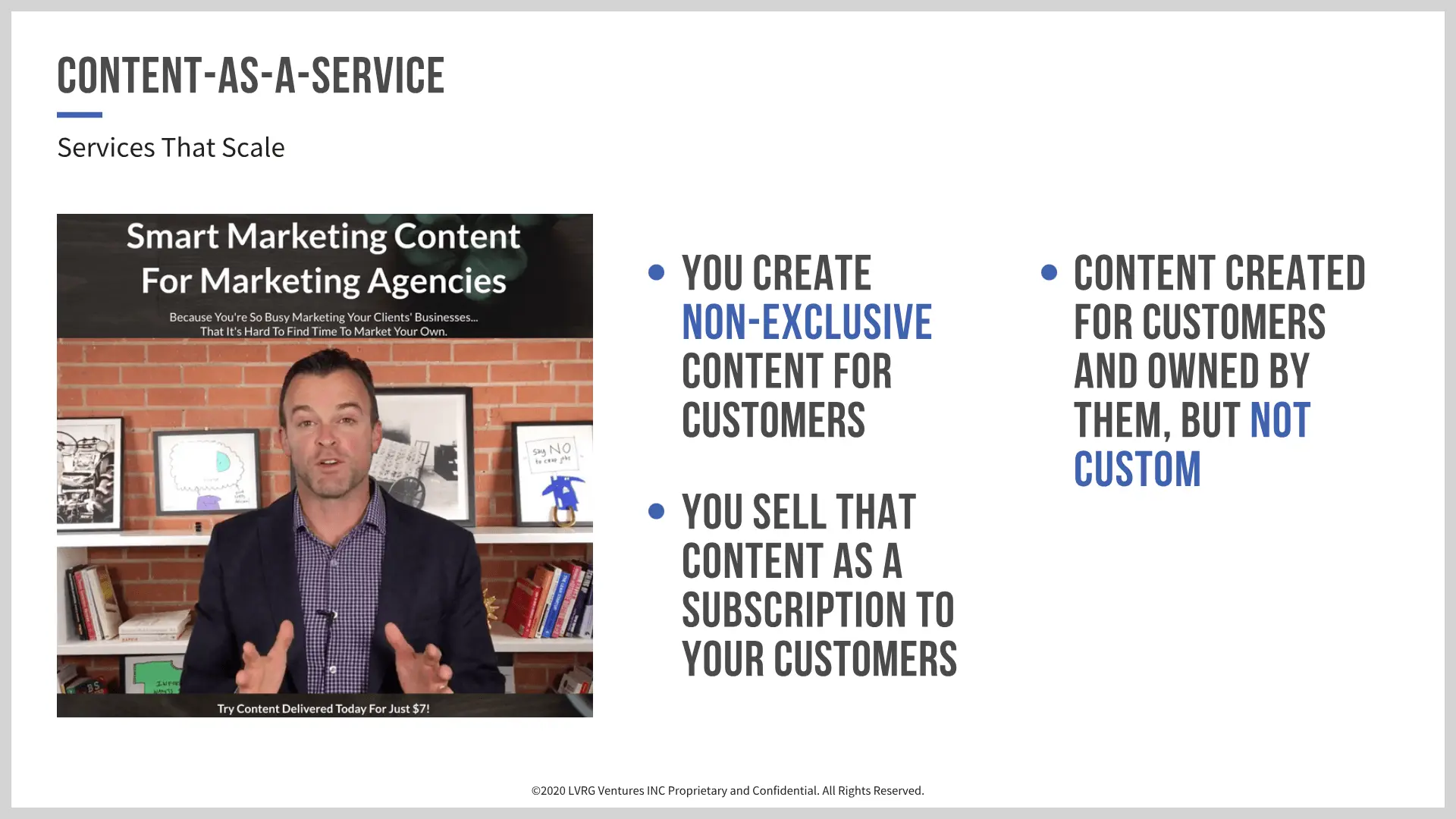
I provide content to marketing agencies, to help them market their business.
Here’s the deal—it’s a very inexpensive service; you can sign up for my content service for $67 a month. You get 30 days of social posts and 4-5 blog posts every month. You get a newsletter put together for you every month.
How can I do it so cheap? Well, it’s non-exclusive content. So what I mean by that is all of my customers get the same content.
I’m not creating custom content…I’m creating one set of content and giving it to all my customers.
Now, you may think, “Mike, you can’t have all your customers using the same content! What about the overlap?” All that stuff and duplicate content in search engines.
I sell them the content making sure they’re aware:
- You should consider this content 80% done. You need to do the final 20% to make it yours—to add your angle, customize it for your market, whatever you want to do.
- You should be using this content in a way that is not focused on ranking. So you’re not doing any duplicate content problems.
And in the 10 years of doing this, I’ve had maybe 2 people complain. So it’s a great model because I produce the content once. I sell it to hundreds or thousands of customers and I’m getting monthly recurring revenue from the content.
It’s a beautiful value proposition for my customers because normally, to get one blog post written, they’d be paying a lot more than they’re paying me for my service, creating all that content for them each month.
There are huge opportunities to do this with small business content…you could do this for blog posts, newsletters, social posts, videos, etc.
Pick a particular industry where they need regular content for their marketing, produce that content, and sell it out again to those small businesses.
It’s a really attractive model.
Model 5: Assembly Lines
Assembly lines are where you simply have a process for creating something that your customers need, but you can do it more efficiently and effectively than they could.

So a newsletter is a perfect example. Every business knows they should be sending a newsletter. A very small percentage of them are doing it because it’s a pain managing it internally.
Who’s going to manage it? Who are we going to get to write the articles? Our staff is busy.
They’re not enthusiastic about writing articles either.
In fact, this business here, Newsletter Pro, I think they’ve got 60-65 employees where they just assemble newsletters for customers every single month.
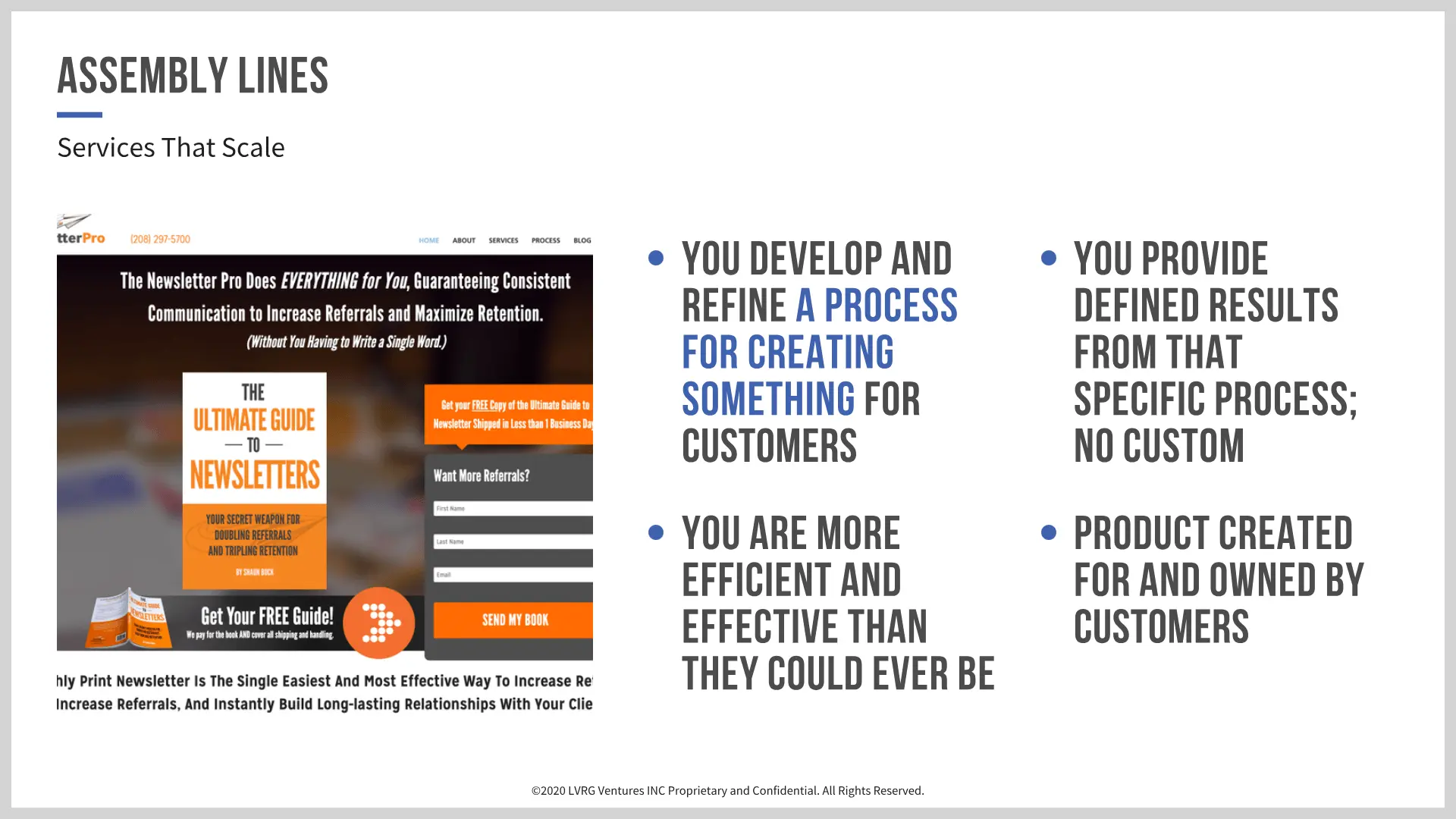
It’s a great business.
Everybody knows they should be sending a newsletter so these guys can do it more effectively, more affordably, than their customers ever will. And it’s a great relief for those small businesses to just be able to hand it off.
So this is where you are creating something custom for your customers. Not my content service, where I’m producing the same newsletter. This is where you’re assembling something unique.
And it’s going to be at a higher price point and more high-touch service. But you could do this for:
- Blog posts
- Newsletters
- Social posts
- Videos
- Podcast episodes
- Ads
- eBooks
- Lead magnets
This is all content that needs to be assembled for small businesses. Things they really struggle with producing on their own. So assembly lines are a great model.
Model 6: Micro-Management
One of the tendencies that people in the agency business have is to try and take on everything, and be the “end all be all” for a niche.
But in this service model, you have options to do something more focused where you’re not trying to be the “end all be all” system for an industry.
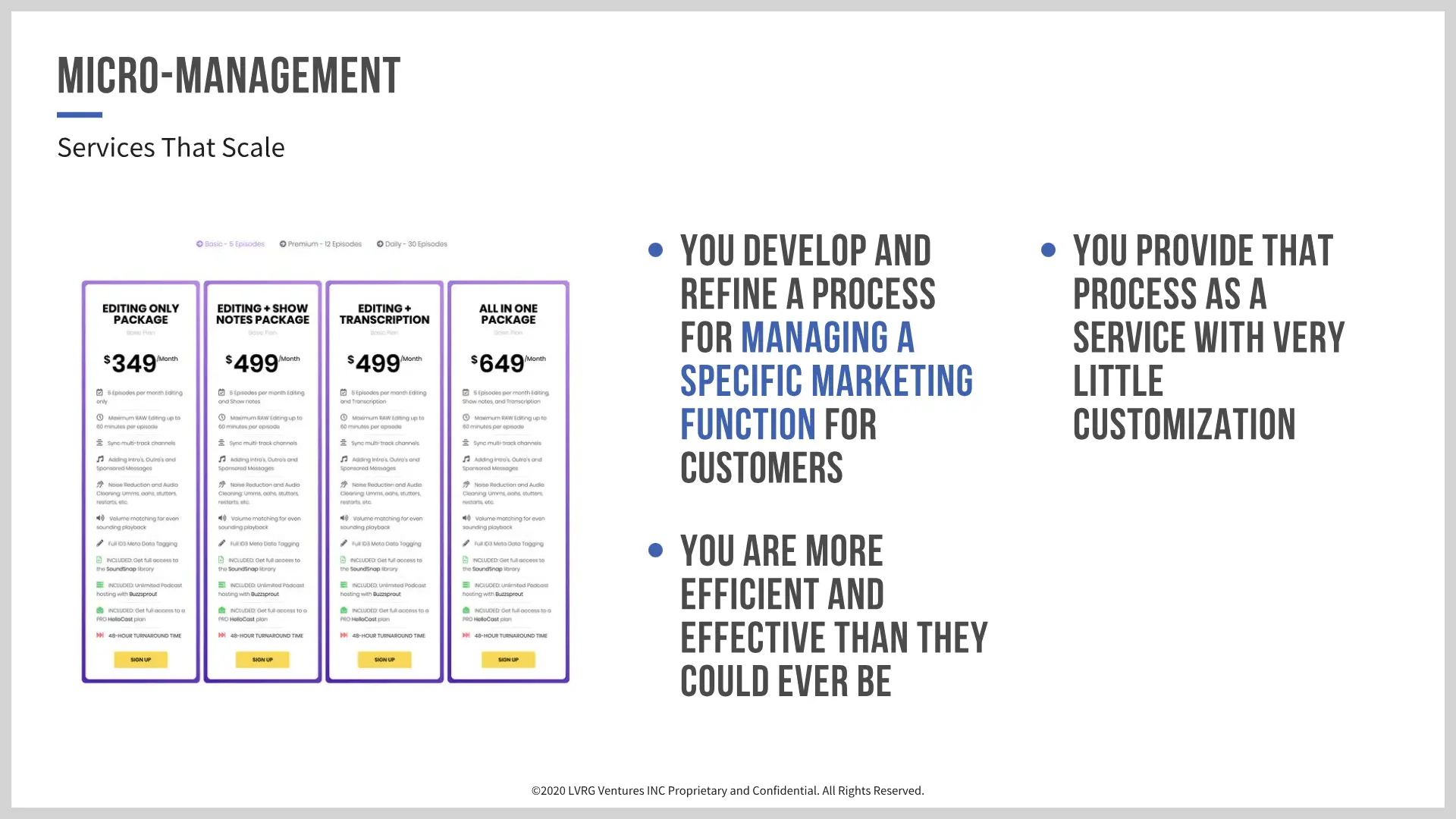
A great example is Chat Conversions. It’s a fast growth business. And all they do is manage the chat process. That’s micro-management. You manage a very specific marketing function for customers.
It’s about efficiency and effectiveness. Every business should have chat on their website. Why don’t they? Because who’s going to staff the chat? Make sure we’re responding in a timely manner?
It just creates headaches for customers to add chat to their site, even though it makes sense. Most businesses aren’t going to do it.
These guys say: “Hey look, we’ll staff, we’ll train, we’ll manage the chat for you. We’ll do it all with our proven scripts and proven approach. We’ve got all the tools, all the technology. Just sign up at $97 a month, $297 a month…and we’ll have you up and running like that.”
It’s a great service. You could do this for:
- Podcast management
- Community management
- Chat management
- Social media management
- Content repurposing
- Email marketing management
- Reputation management
- Lead follow up
You don’t have to try and do everything. Just bite off very specific functions and processes and do them really well. And oddly enough, when you do less, it’s usually much more scalable because you’re so focused.
Model 7: MSP
Many try to be an all-in-one agency handling everything for a niche industry. But as an agency doing custom work, small businesses can’t afford what you need to charge.
Instead, be an MSP—a marketing systems provider. Develop a system integrating tools, assets, and services focused on an industry. Make it efficient and low-cost.
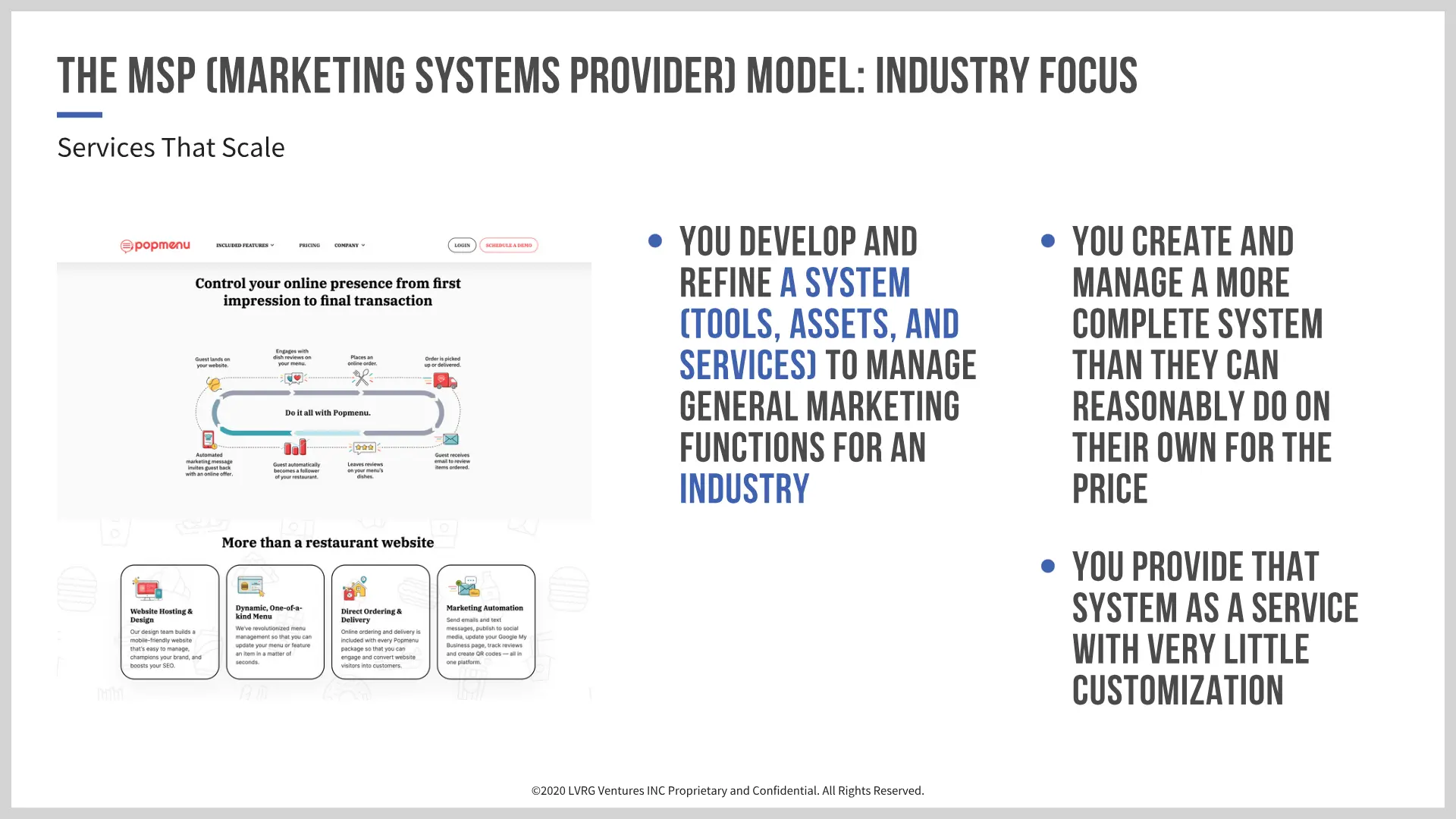
Popmenu is an example, growing fast for restaurants. Their system pricing starts at just $97/month because it’s not customized. But it’s a high margin, semi-automated, and still delivers value.
I’ve built 7-figure businesses on this MSP model and sold one for millions.
Model 8: SaaS
Then finally number eight here is SaaS, software as a service. We’re all aware of how attractive the SaaS business model is. That’s why venture capitalists are putting so much money into it, and that’s why you hear about the unicorns.
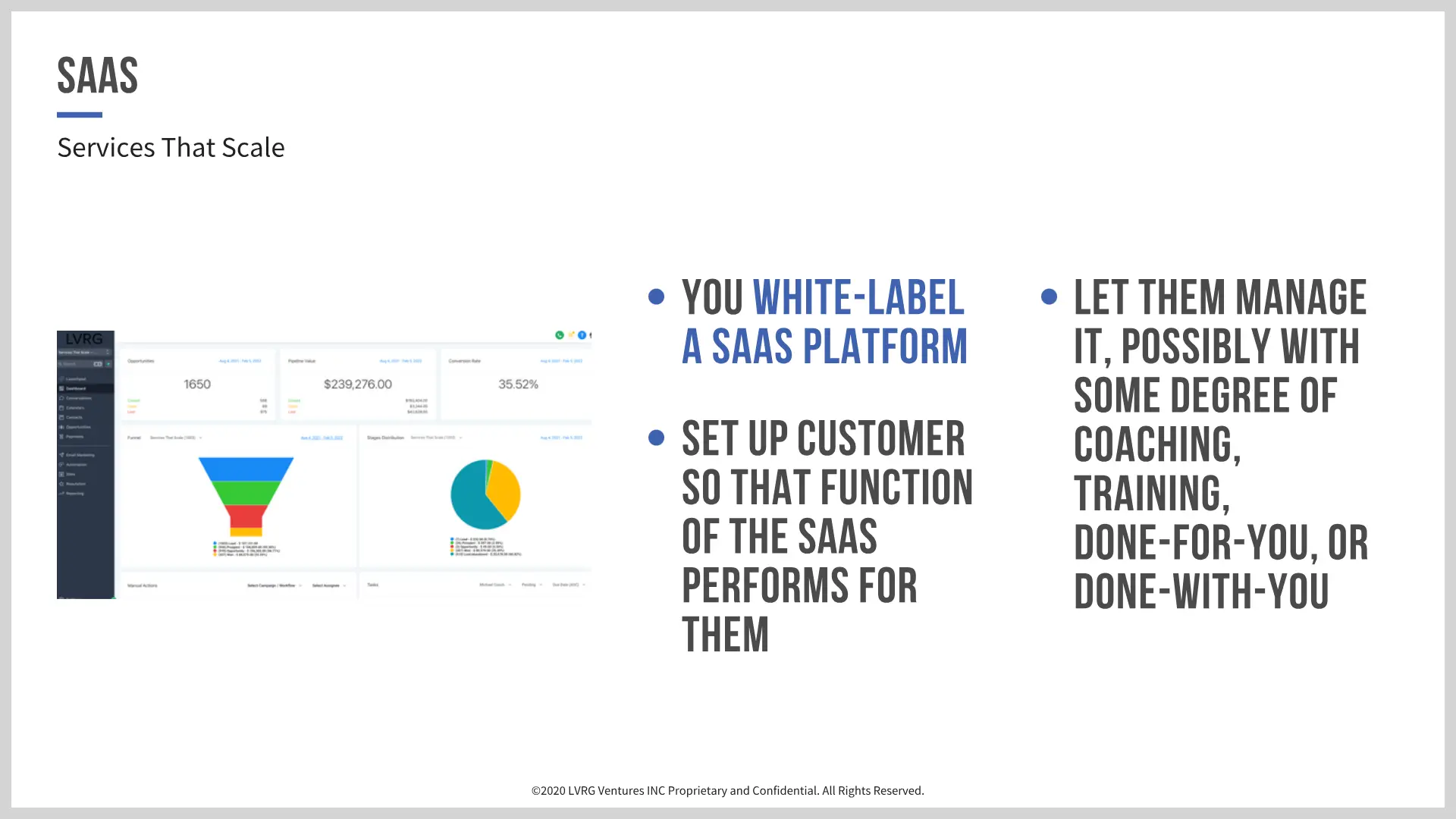
Those billion-dollar-plus companies are almost all SaaS companies. And in the small business space in particular, almost every good-size successful business is a SaaS business.
Why? Because it lines up well with the small business market.
You can deliver a tremendous amount of value through software but at low price points, generate recurring revenue, and bring on customers who have been with you for years and years.
It’s a great business model.
So the awesome thing is you can be in the SaaS business now. This screenshot here is the HighLevel platform that I use every day for my businesses.
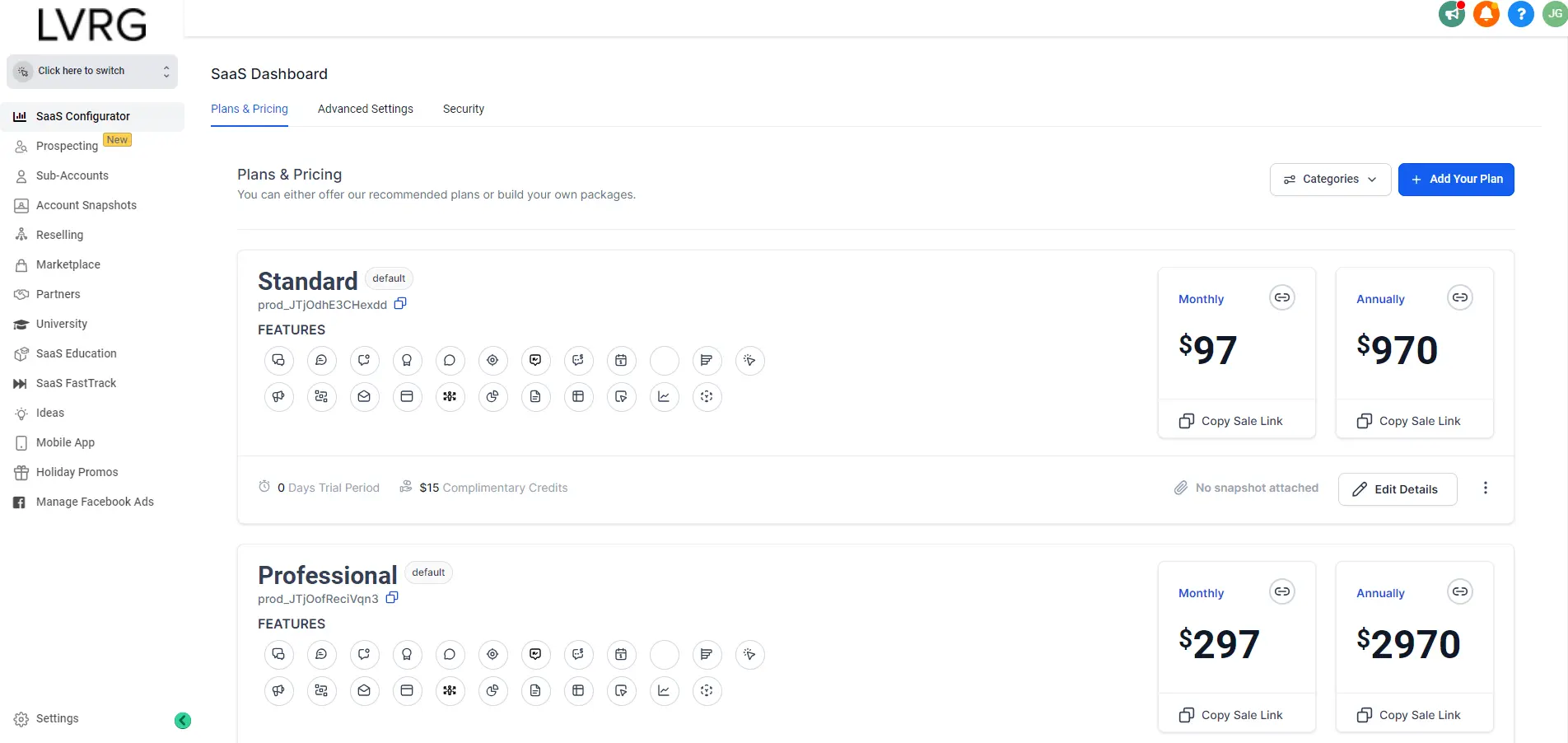
It’s also a SaaS platform and SaaS opportunity that I can then sell to my customers white label. So it’s completely my business, my business model, my customers don’t see anything about HighLevel.
And I can get all the benefits as if I developed my own SaaS platform. And you can sell the platform just on its own, just sell SaaS.
But you can also layer on top of its coaching, training, and some done-for-you services. So you’re still more of a service provider instead of just a tools provider.
You can give your customers more handholding on top of that platform, so you can charge higher prices than just a normal SaaS. And make a ton of money with a very scalable opportunity.
As an example, there’s ClickFunnels.
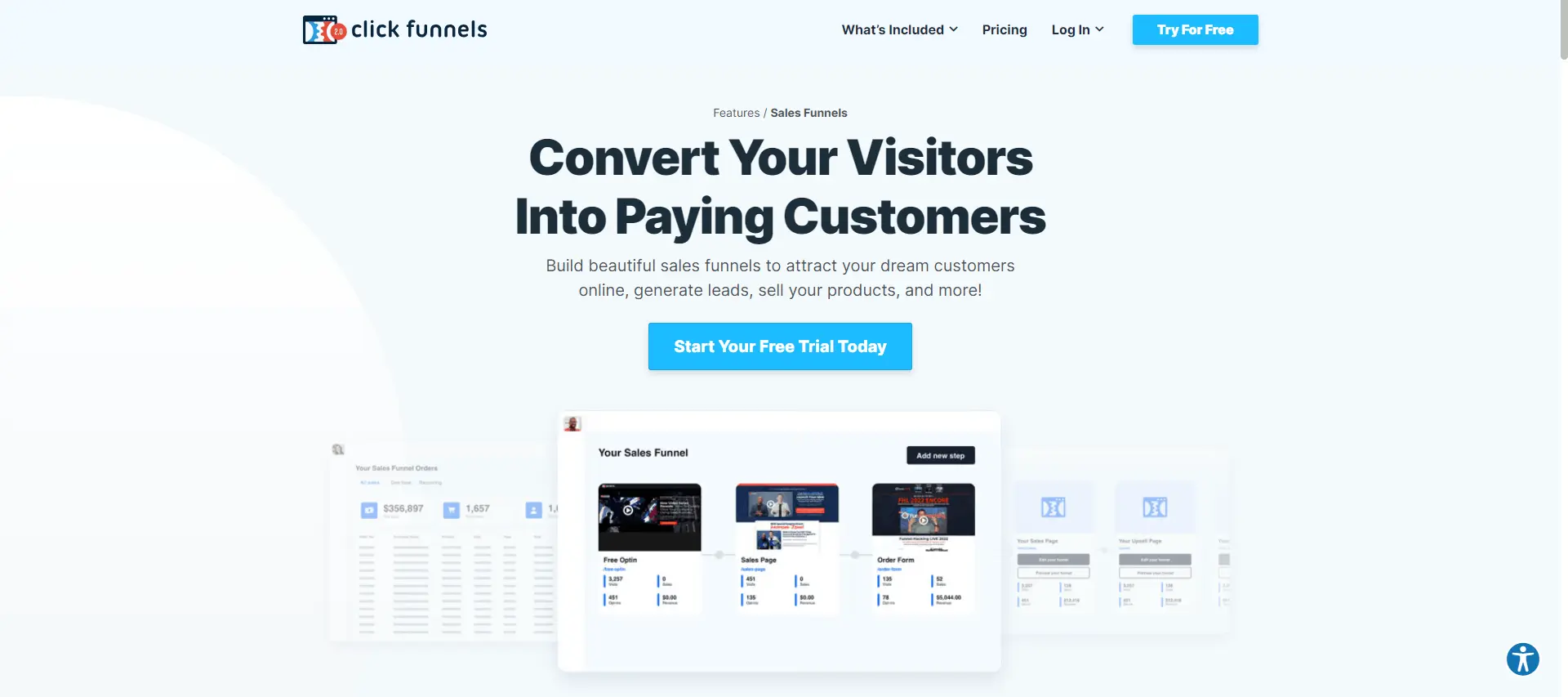
Theoretically, it could be sold to every small business to grow their business. But realistically, a pizza shop owner doesn’t know anything about building funnels.
Theoretically, it could be sold to every small business to grow their business. But realistically, a pizza shop owner doesn’t know anything about building funnels.
They want to serve really good pizza.
So you could deliver the HighLevel platform to them but layer on services so the pizza guy isn’t expected to just use the tool himself. He won’t do that.
But if you deliver it as the foundation of your service and layer benefits on top, you can build a really nice service.
Forget the Agency Business Model as You Know It
So those are eight proven models that are super scalable and get you customers, not clients.
They allow you to build a business that protects your time so you’re not getting calls at 11 o’clock at night from clients.
AND they build an actual asset that you can sell instead of just putting you on a treadmill of working for more and more bosses and, unfortunately, probably getting paid less than you would if you just went out and got a really good job.
So forget the agency business model as you probably know it. Don’t sell your time. Don’t sell your talent. Invest in creating a business around services that scale.
You’re going to go through all the hard work of building a business anyway; why in the world would you not build one based on a better business model that’s going to get you many times the reward?
All the best,
PS – I made six shifts in my approach to building my business that allowed me to grow quickly and stop trading my time for money. You can learn them here 👈🏻
PPS – Here are two ways to get involved with our community of entrepreneurs. Both will give you everything you need to go from where you are today to running a successful seven-figure agency:
Click here to sign up for HighLevel CRM through me. All of my HighLevel CRM customers get access to Moguls for FREE—Just part of the huge Bonus Package I provide.
Click here to join Moguls directly. You’ll get access to all of our live boot camps, content, and community that have helped folks just like you scale to seven figures and beyond!


